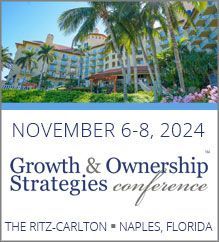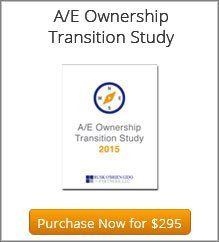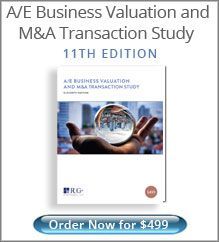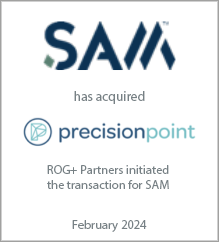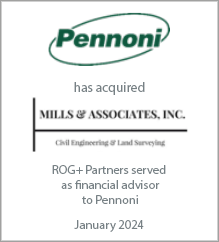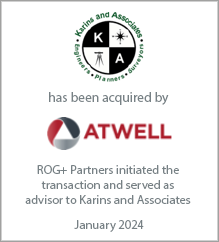Steve Gido specializes in corporate financial advisory services with a focus on mergers and acquisitions. Steve has assisted architecture, engineering, environmental consulting and construction firms of all sizes across North America achieve their growth or liquidity goals through successful mergers & acquisitions. Steve has over 15 years of investment banking experience and holds the chartered financial analyst (CFA) designation from the CFA Institute.
Fundamental Goals for A/E Firms Exploring a Sale
Fundamental Goals for A/E Firms Exploring a Sale
December 1, 2010
Over the years I had grown close to a well-run multi-disciplined consulting engineering firm that really seemed to have a lot of great things going for it. A mid-sized player, its diversity across various services, markets, and public and private client bases enabled it to withstand the recession much better than its peers. It was historically profitable and had a knack for consistently growing at 8-12% a year. The firm had a hard-working and humble culture, recognized for quality projects and low employee turnover. Management had initiated discussions with staff members about broadening its ownership profile and regularly reinvested profits back into training, systems, and professional development. It wasn’t without its occasional challenges or turmoil, but was a model firm in many ways.
They sold to a large buyer this year.
Obviously surprised, I later spoke with the President to learn more about their thought process and rationale. Turns out their executive team had entertained discussions from sincere suitors over the years and were quietly exploring the merits with each passing encounter. He offered that their reasons were multi-faceted: they privately worried whether their younger generation had the entrepreneurial acumen and financial means to buy out the aging senior team (which would soon be facing sizable stock redemption liabilities); they saw the potential for a good cultural and synergistic fit with an unsolicited suitor who was affording them some degree of autonomy at a “fair” price; they had growing concerns they were too small and lacked sufficient capital to compete with multi-regional and national players who were encroaching into their territory; and they felt uneasy about not having a solid leadership succession plan.
Surveys show that the vast majority of A/E and environmental consulting firms would prefer to perpetuate the organization through internal ownership transition and advancement rather than an outside merger or sale. However, for organizations big and small, and particularly those with owners who delayed or failed to implement a formal transition plan, an outside sale may be the only credible alternative.
So with that in mind, what should be your fundamental goals for a sale process or if you receive unsolicited opportunities from various suitors?
Most owners only get to sell their firm once and having a clear, realistic understanding of your goals going into the process is more than half the battle. Our experienced team has helped hundreds of A/E and environmental consulting firms of all sizes and disciplines recognize their ownership transition and exit strategy goals. Please contact me with any thoughts or observations on M&A activity of if we can ever assist your organization.
They sold to a large buyer this year.
Obviously surprised, I later spoke with the President to learn more about their thought process and rationale. Turns out their executive team had entertained discussions from sincere suitors over the years and were quietly exploring the merits with each passing encounter. He offered that their reasons were multi-faceted: they privately worried whether their younger generation had the entrepreneurial acumen and financial means to buy out the aging senior team (which would soon be facing sizable stock redemption liabilities); they saw the potential for a good cultural and synergistic fit with an unsolicited suitor who was affording them some degree of autonomy at a “fair” price; they had growing concerns they were too small and lacked sufficient capital to compete with multi-regional and national players who were encroaching into their territory; and they felt uneasy about not having a solid leadership succession plan.
Surveys show that the vast majority of A/E and environmental consulting firms would prefer to perpetuate the organization through internal ownership transition and advancement rather than an outside merger or sale. However, for organizations big and small, and particularly those with owners who delayed or failed to implement a formal transition plan, an outside sale may be the only credible alternative.
So with that in mind, what should be your fundamental goals for a sale process or if you receive unsolicited opportunities from various suitors?
- Seek a Similar Culture – This may sound obvious, but an A/E seller’s main goal should be to join an organization where there is management compatibility, a similar design philosophy, and a clear understanding as to how both firms will successfully work together. Of course, “culture” can always be a bit nebulous, but there should be an excitement and likeability among the parties and the strategic intent should guide the transaction, not the other way around. In this climate, sellers really need to perform their own due diligence on a buyer. Understand its mission, organizational structure, financial strength, and strategic goals. Talk to the leaders of other firms they may have acquired.
- Maximize Valuation – No surprise that differences in price expectations is the number one deal breaker. However, sellers need to fairly evaluate what they could expect to earn in future dividends and distributions from remaining independent over a period of time vs. the proceeds they would be receiving from a buyer. In addition, they also need to evaluate the valuation from an internal transition option vs. external sale perspective. As we frequently see, many sellers often have inflated expectations of value.
- Understand the Consideration – There’s no one formula when it comes to the forms of consideration used in A/E transactions and it typically depends on the buyer’s capital structure, ownership profile, risk management, and, ultimately, its negotiations with the seller. Cash, installment notes, buyer stock and/or contingent consideration can all be utilized. Each form requires its own investigation to understand what triggers payment (and when) and what restrictions might be in place.
- Minimize Taxes – Keep in mind that A/E transactions need to be assessed in aggregate and that valuation is not the same as after-tax proceeds! How a transaction is structured (asset or a stock purchase) and ultimately paid out could have drastically different tax treatments and is equally as important as “the number” you’re offered in the letter of intent. Seek tax counsel to understand what you’ll be receiving and what will go to Uncle Sam.
- What’s Your Role? – For many owners and entrepreneurs of small to mid-size A/E firms, there needs to be a change in mindset to working in a larger organization, oftentimes with more formal rules, communications, and procedures. Key management needs to have their roles, responsibilities, compensation and perquisites, and reporting relationships clearly defined. Oftentimes, leaders may want to leave out of frustration and conflicting expectations, but may not realize (or forget!) the negative ramifications in place due to restrictive covenants in their employment agreement.
- Smooth Transition – Fundamentally, M&A is a significant change event, which is something many engineering, architect, and environmental professionals don’t profess to like! Understand that your staff will have many questions, from their employment status to even the slightest change in their benefits. The goal should be to minimize the operational disruption as much as possible and that usually comes from communicating clearly the rationale, merger benefits, and integration processes to staff, clients, and other stakeholders.
- Reduce/Remove Liabilities – Sellers generally prefer a stock transfer/sale rather than an asset one at closing primarily because the buyer will retain all of the seller’s liabilities, including those direct and contingent (i.e., known and unknown). This “clean break” can also be a way to relieve owners of personal guarantees they might have on various forms of debt outstanding.
- Minimize Earnouts – Earnouts, or pay for performance contracts, are often used in A/E and environmental consulting transactions as a way to bridge gaps in valuation and as an incentive mechanism to achieve future financial targets. Buyers have different philosophies on them. Some like them as they shift part of the price and operational risk to the seller, but others find them a disincentive to effectively working and collaborating together. Heavily negotiated, they can be constructed in many different forms and mechanisms, but sellers generally prefer as little exposure to them as possible.
- Maintain Confidentiality – Keeping discussions quiet and private and ensuring that due diligence documents will be kept with fiduciary care and responsibility is a must. Review and execute non disclosure agreements up front. Rumors and leaks could potentially be bad for productivity and morale, and end up causing internal disruption at a sensitive time.
- Recognize Post Closing Items and Indemnification Provisions – Beyond the main transaction points outlined in a term sheet, there are other significant deal elements that are often aggressively negotiated right up until closing. Typically buyers will demand that a certain part of the purchase price remain in a holdback escrow until certain conditions are met, such as A/R collectability or other working capital adjustments. On the indemnification side, either a “basket” or a “cap” is utilized should there be any claim for breach of representation or warranty that requires resolution. Also, the need (and cost!) for sellers to purchase tail insurance, or E&O liability coverage for prior acts under a claims-made policy, is often not anticipated. All of these nuances fall under the “art of the deal” category and should be explained and discussed with experienced A/E legal counsel.
Most owners only get to sell their firm once and having a clear, realistic understanding of your goals going into the process is more than half the battle. Our experienced team has helped hundreds of A/E and environmental consulting firms of all sizes and disciplines recognize their ownership transition and exit strategy goals. Please contact me with any thoughts or observations on M&A activity of if we can ever assist your organization.
Latest Perspective
Perfecting the A/E Exit Strategy – Five Key Factors
An enormous A/E generation that kicked off their careers in the 1980s and subsequently started firms or became owners in the 1990s ...
© 2024
Rusk O'Brien Gido + Partners, LLC
Financial Experts for Architects, Engineers, and Environmental Consulting Firms


